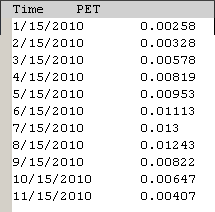Evapotranspiration
Importing evapotranspiration (ET) values is useful for tracking soil moisture in Vflo™ models. For Desktop Vflo™, there are three options for loading ET values.
- 1. Constant Value: applies the same value for all times at all cells.
- 2. Single Time Series: loads the evapotranspiration model from a single file.
- 3. Spatially Variable Time Series: accepts multiple ASCII files.
Potential ET is modified according to rainfall and available soil moisture in each cell.
Another ET option, Spatially Variable Coefficients, may be used in conjunction with any of the three main ET methods described above. For this option, ASCII file values should be coefficients that will be applied to the ET value of corresponding cells. It is not necessary to load any coefficient files if they are not available or needed.
Evapotranspiration file format requirements
As long a time series as necessary can be loaded, even for multiple years. However, if the model is run with times that are not included in the model, then coefficients will be looped over the years.
The units of ET time series files should be either inches/hour, if US customary units are used, or millimeters/hour, if metric units are used. Select the correct units from within the Evapotranspiration dialog.
Single time series formatting
The input single ET time series file must be a tab delimited text file in the format demonstrated by the sample ET time series below. Values given are for demonstration purposes only; representative values for the user's watershed should be used when preparing evapotranspiration time series.
The header line must contain the text "Time" and "PET" separated by a tab. The date and ET values must also be tab delimited. The time format must be either: MM/DD/YYYYor YYYY/MM/DD.

Spatially variable time series and spatially variable coefficients formatting
Spatially variable time series must be in ESRI ASCII grid file format (*.asc). ASCII files should match the Vflo™ domain, as described here. When using Spatially Variable Time Series or Spatially Variable Coefficients, file names should include numerals giving the times of the files in the format: yyyyMMddhhmm.asc. For example:Evap_200810080500.asc. Any values less than "0" will be assumed to be "0".
Using Continuous Simulator to continuously track soil moisture
Event-based simulations are not greatly affected by ET during the event. During continuous simulations, however, soil moisture is depleted by actual ET and has a significant effect on runoff volume and initiation of hydrographs. For the longer durations that can be modeled with the Continuous Simulator extension, time-variable evapotranspiration (ET) may be entered as either climatological values for an annual cycle, or as a timeseries of values that are representative for the period simulated. If climatological values or a timeseries are to be used, be sure to include sufficient ET values to cover the period of simulation in order to avoid unexpected results. If only one year is included, then the model will continue to use that year of values for the entire simulation period.
A Continuous Simulator license must be present in the Vflo™ directory in addition to a Desktop Vflo™ license in order to access Continuous Simulator functions within Vflo™. To order Continuous Simulator, contact Vieux & Associates, Inc.
For detailed information on running Continuous Simulator, see the Continuous Simulator page.
